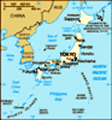Advertisement
Published: August 24th 2017
As we were getting ready to leave Chiba yesterday morning, it struck me that we might be able to stay on in Kamakura for another night, if we so wished. Toss in an extra t-shirt and another set of undies, and why not? As I said to Stephen, "We don't have any cats to feed," and this is a thought also crossed my mind (and this will show why it's a jolly good thing we don't have kids): "It's not like we have a baby to come home to." So, fairly soon after our arrival we discussed it and decided, yes, we would like to say another night. This gave us all day today to spend without without worrying about time-limits or the two-hour trip back to Chiba, and it was lovely.
Last night we made contact with a friend from our NZ days, and the plan was that she would call us at the hotel at 9 this morning to confirm that we would meet today. We spoke to her before we spoke to Ebi, so we couldn't be 100% sure that Ebi was going to be available last night thus leaving us free today. So at 9 this

 Hachiman Jingu
Hachiman Jingu
Bridges at entrance to shrine. The stone one is built steep to show the difficulty of crossing between life and death (or something). Note also the fire-shaped tree between the bridges.morning I was just positioning myself near the phone to be ready for her call, when there was a knock at the hotel room door, and there she was. So that made it easy, and we got a quick start to the morning. We had been called for breakfast at 8am, and when we got to the restaurant there was just the one table set for a Japanese breakfast - we are the only guests in the hotel! It was a proper Japanese breakfast: fish, pickles, rice, soup. It's been a while since we've had that - maybe not since we were travelling round staying in Youth Hostels in 1985.
We set out with Tomomi, as first we wanted to go back to a really steep bridge we remembered from 1985 and recreate a photo of Stephen toiling up it. Nearby we remembered a beautiful little shop that sold miniatures: little paper toys and sculptures (origami and otherwise) that Tomomi said still existed - in fact she said it was famous. And here I thought I'd discovered it by myself. The shrine whose bridge it was is not too far away, and the miniature shop was round the corner
from it, but the shops were still closed, and when we got to the bridge, it was closed to the public also. So a bit of a washout all round, really, but visiting the shrine with a local was good: we were able to ask a lot of questions that previous we'd only puzzled over between ourselves. Like, can you tell the difference between a shrine (Shinto) and a temple (Buddhist) just by looking from the outside? And the answer, apparently, is no. Both have gates, but either can be stone or wood, natural or painted, and the style of gate depends more on the era of construction than the religion involved. Both can have scary-looking warriors guarding the entrance, too (I had thought that was Buddhist only). Natural dark wood, vermillion painted pillars: neither is significant, both can be either. No wonder I've been so confused for so long. So we walked up to Hachiman Jingu to see the shrine building itself, and back again to the bridge at the entrance, and then along the main street of the town, which has a pedestrian walk going up the middle for the whole length of it. This commemorates the original

 Enoshima
Enoshima
Looking towards the island of Enoshima from the mainlandentrance to Kamakura a thousand years ago, when the town was surrounded by hills and the sea was the only access, but the roads were deliberately built to be so narrow that any potential invaders would have to enter in single file, even dismounting and walking, in order to attack the government seat.
From Kamakura Station we then took a train two stops to Tomomi's own neck of the woods, but we changed there straight onto a monorail that took us back through Kamakura (but at a tangent) to Enoshima, a popular tourist spot. It is an island, but connected to the mainland by a bridge of maybe 400 metres, so it's very easy to walk to. A little lane of shops takes you to another shrine entrance, which you explore by climbing a lot of steps. There is an escalator but we took the steps, but we didn't go very far around the island. (I do remember being taken all the way around it once before, and it turns out that that was probably by Tomomi and her father, in 1997.) This time we looked out at a lookout, then turned around and came down again.
We
started looking for a place to have lunch, but Tomomi said she had a place in mind, just a few minutes away. It wasn't in the shrine grounds, it wasn't in the lane leading up to the shrine, there were no restaurants on the bridge, so in fact we were back on the mainland for lunch about 20 minutes later, although just over the bridge and round the corner. We did have to stop for a drink and a sit-down, because it was a very hot and sunny day, and Stephen's blisters are still hampering him a bit. Finally we got there, and we were only third in the queue! But we were called inside in only about 7 minutes. It was a seafood restaurant, but none of the pictures on the (very limited) menu looked like anything we knew, so we plumped for the safest. The meals turned out to be very artsy-fartsy, pretentious kinds of dishes, to the extent that the waitress had to spend several minutes explaining to Tomomi how to eat it (and that was for her benefit, not for her to tell the ignorant foreigners.) This was such wanky food it came with instructions. ("Don't
put any soy sauce on it, because it already comes with the right amount of the right sauce. Use this dried seaweed to make your own hand-rolled sushi, using little dabs of this or this for extra flavour.") The meal was okay, but not fantastic. Ours was rice with shredded or minced cooked fish (very dry), and chopped cucumber and chives on top, and it was probably the least interesting meal we've had here. But Tomomi enjoyed it, and she shouted us, so that was okay.
After lunch, we came back to the hotel for a rest, with the plan to meet Tomomi and her parents at her station, and we would go out for dinner. I was gradually remembering that I had visited them - even stayed with them - in 1997, and when they came they recognised Stephen too because - apparently - they visited us in Perth in 2004! We had no recollection of this at all. They showed us photos, and I still don't remember it. We walked through the night streets of Ofuna for several blocks to visit the restaurant of some friends of hers, now an elderly couple, but who have been running
this restaurant for about 20 years. It's called Mama's Kitchen, but it seems that Papa is the ideas man. We had several dishes from the menu, but he also brought out a few other dishes for our delectation. He was very proud of his fish gyoza (gyoza are little crescent-shaped steamed-then-fried dumplings, sometimes called pot-stickers, especially by Americans) because gyoza are usually filled with meat, but he thought they should try fish. They were good, and not very fishy. We also had his cheese and bacon spring rolls - excellent! Their whole line is that the food is home-cooked, just like in your mama's kitchen, and it really was a good meal, and lots of fun. Tomomi's mum and dad brought photo albums of their trips to Chch and Perth, and we had a lot of reminiscing.
Walked back to the station, parted with hugs and promises to visit Vietnam, got home, write this, then bed. Save the blog but forget to hit "Publish." Wake up in the morning, rework the ending, save and again and this time hit "Publish."
Advertisement
Tot: 0.136s; Tpl: 0.014s; cc: 10; qc: 48; dbt: 0.1006s; 1; m:domysql w:travelblog (10.17.0.13); sld: 1;
; mem: 1.1mb







